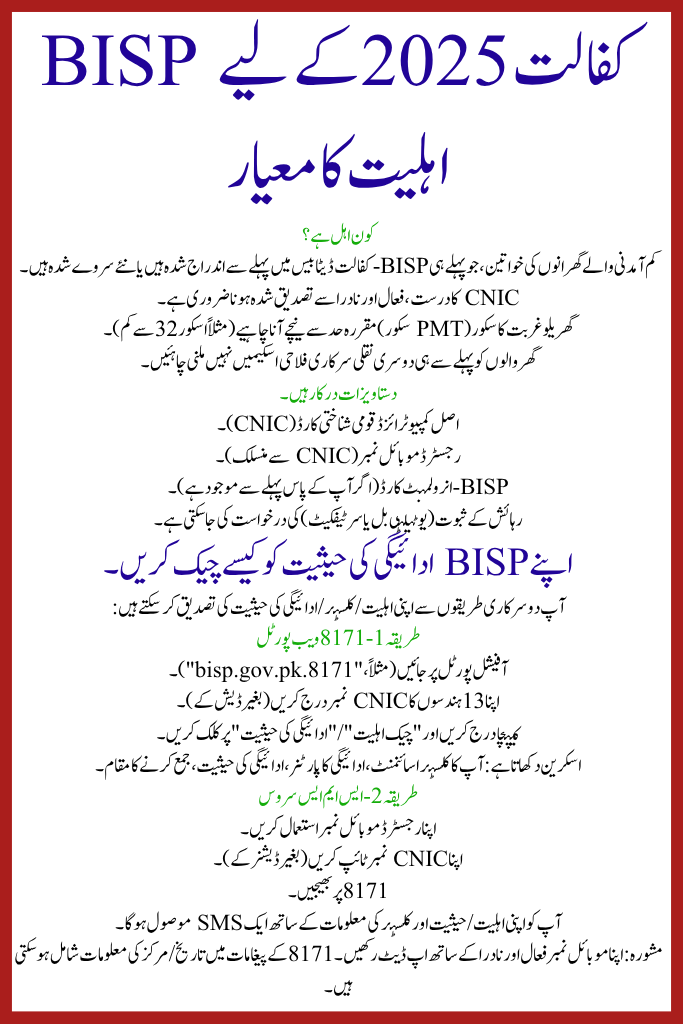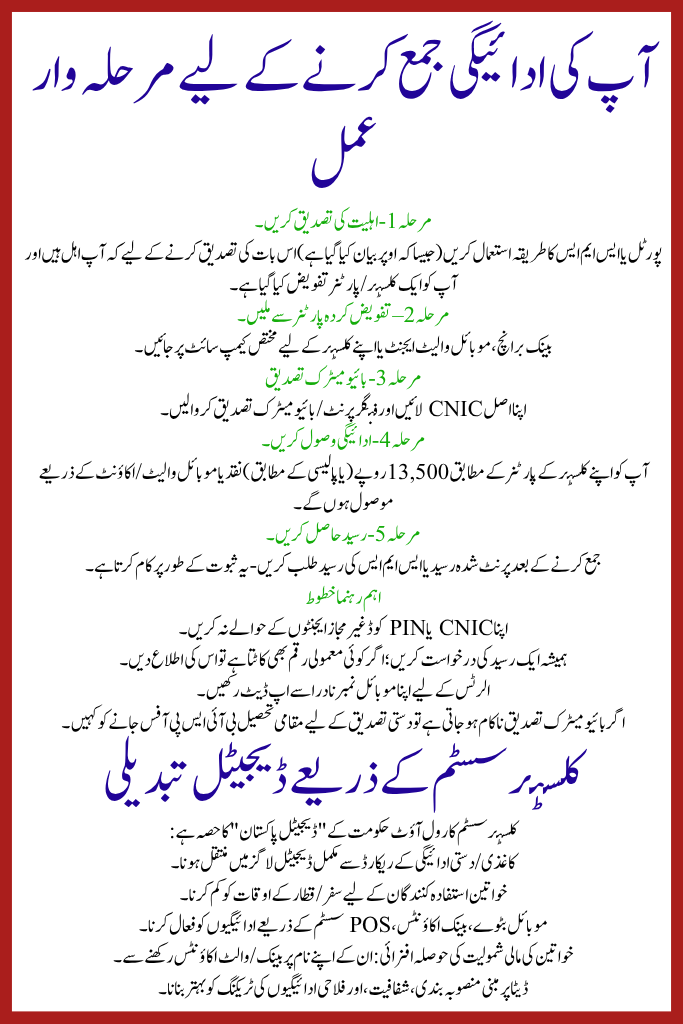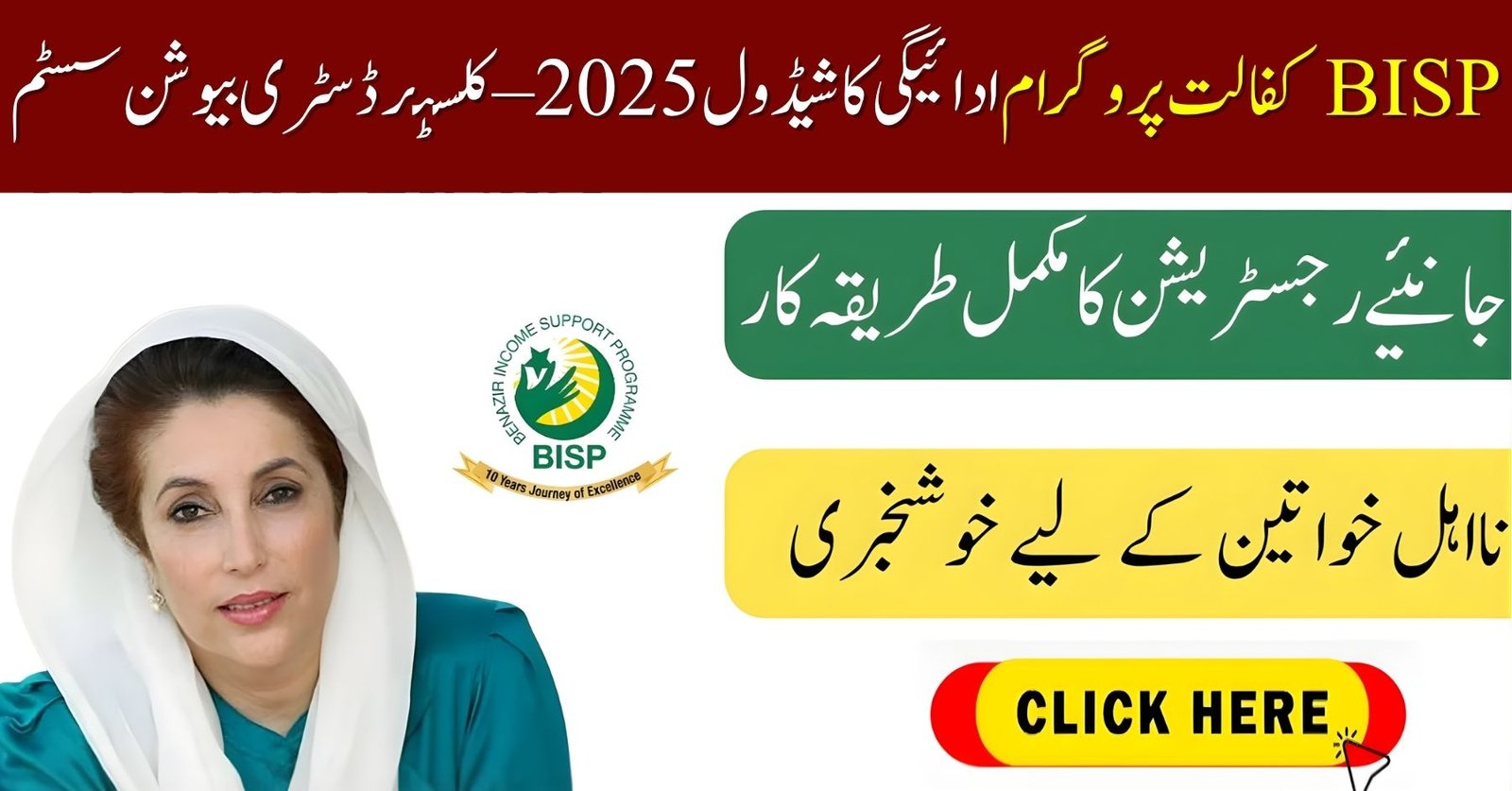BISP Kafalat Program Payment Schedule
The BISP Kafalat Program Payment Schedule 2025 under the new Cluster Delivery System brings a big development for eligible women crossways Pakistan. Under this scheme, decided by the Benazir Revenue Support Programme (BISP), each eligible woman obtains Rs 13,500 (per instalment) safely, on period and without deduction. The new construction gulfs each district into bunches and allocates trusted sum partners (banks/mobile wallets) to brand the procedure transparent and efficient.
Here’s a quick “at-a-glance” table of core details:
| Program Name | Start Date | End Date | Amount of Assistance | Method of Application |
|---|---|---|---|---|
| BISP Kafalat Program – Payment Cycle 2025 | 16 October 2025 | In phases (see schedule) | Rs 13,500 per eligible family (quarterly) | Online (8171 portal / SMS) & in-person verification |
- This is the major disbursement date for October 2025 cycle; other clusters may have different dates.
Overview of BISP Kafalat Program 2025
What is it?
The BISP Kafalat Programme provides direct cash transfers to women from low-income households, as part of Pakistan’s social defense schedule. The 2025 reforms emphasise:
- Digital inclusion
- Financial transparency
- Removal of middlemen and corruption
Why new Cluster Distribution Model?
Under the new model:
- The country’s districts are alienated into clusters, each served by a exact payment spouse (e.g., banks, mobile wallet providers).
- Benefits: fewer queues, faster payments, traceable dealings, less accidental of fraud.
- The government aims that every eligible female receives the full quantity — Rs 13,500 — safely and on time.
This marks a main shift toward modern, numerical welfare distribution.
Understanding the BISP Kafalat Program Payment Schedule
What is a “cluster”?
A cluster is a sub-division within a district: smaller, wieldy geographic section. Each bunch is assigned one sum partner (e.g., bank or mobile wallet).
How it works:
- District segmentation: Each district is mapped into clusters based on population and geography.
- Partner assignment: Each cluster gets a partner (e.g., Habib Bank Limited (HBL), Bank of Punjab (BOP), JazzCash, Easypaisa, Habib Microfinance Bank).
- Digital disbursement: Funds are processed electronically; beneficiary verifies via CNIC and biometrics.
- Beneficiary Verification: At point of collection the woman presents her CNIC, does fingerprint/biometric check, and collects cash/wallet transfer.
Major benefits of cluster model
- Faster payments: Real-time digital transfers cut waiting times.
- No deductions: Since funds go direct, no middleman commission.
- Transparency: Every payment is logged digitally.
- Safety: Women collect only at authorised centres.
- Accountability: Payment partners must report each transaction to BISP HQ.

Eligibility Criteria for BISP Kafalat Program Payment Schedule
Who is eligible?
- Women from low-income households, already pre-enrolled in BISP-Kafalat database or newly surveyed.
- CNIC must be valid, active and verified by NADRA.
- Household’s Poverty-score (PMT score) must fall below the set threshold (e.g., score under 32).
- Household should not already be receiving other duplicative government welfare schemes.
Documents required
- Original Computerised National Identity Card (CNIC).
- Registered mobile number (linked with CNIC).
- BISP-enrolment card (if you already had one).
- Proof of residence (utility bill or certificate) may be requested.
How to Check Your BISP Payment Status
You can confirm your eligibility/cluster/payment status by two official methods:
Method 1 – 8171 Web Portal
- Visit the official portal (e.g., “8171.bisp.gov.pk”).
- Enter your 13-digit CNIC number (without dashes).
- Enter captcha and click “Check Eligibility”/“Payment Status”.
- The screen shows: your cluster assignment, payment partner, payment status, collection location.
Method 2 – SMS Service
- Use your registered mobile number.
- Type your CNIC number (without dashes).
- Send to 8171.
- You will receive an SMS with your eligibility/status and cluster info.
Tip: Keep your mobile number active and updated with NADRA; messages from 8171 may include date/centre info.
Payment Schedule – October 2025 (Sample)
Here is an example of the BISP Kafalat Program Payment Schedule under the cluster system for October 2025:
| Cluster | Payment Partner | Example Districts | Status |
|---|---|---|---|
| Cluster 1 | Habib Bank Limited (HBL) | Rawalpindi, Attock, Jhelum | Released |
| Cluster 2 | Bank of Punjab (BOP) | Multan, Khanewal, Muzaffargarh | In Progress |
| Cluster 3 | JazzCash | Karachi Central, Sanghar | Pending |
| Cluster 4 | Easypaisa | Larkana, Shikarpur, Ghotki | Released |
| Cluster 5 | Habib Microfinance Bank | Nawabshah, Dadu, Naushahro Feroze | In Progress |
You can check your specific district cluster via the 8171 portal to know when your payment will be released.
Step-by-Step Process to Collect Your Payment
Step 1 – Verify Eligibility
Use the portal or SMS method (as described above) to confirm you are eligible and have a cluster/partner assigned.
Step 2 – Visit the Assigned Partner
Go to the bank branch, mobile‐wallet agent or camp site allocated for your cluster.
Step 3 – Biometric Verification
Bring your original CNIC and get fingerprint/biometric verification done.
Step 4 – Receive Payment
You will receive Rs 13,500 (or as per policy) in cash or via mobile wallet/account as per your cluster’s partner.
Step 5 – Get Receipt
After collection ask for a printed receipt or SMS receipt — this serves as proof.
Important Guidelines
- Do not hand over your CNIC or PIN code to unauthorised agents.
- Always request a receipt; if someone deducts even a small amount, report it.
- Keep your mobile number updated with NADRA for alerts.
- If biometric verification fails, ask to visit the local Tehsil BISP office for manual verification.

Safety & Fraud-Prevention Tips
- The BISP enforces a strict “No Deductions” policy: no agent should deduct even a rupee from your payment.
- Collect funds only at authorised centres/banks/agents. Check partner list carefully.
- Never share your CNIC, mobile OTP, wallet PIN or SMS code with unknown persons.
- If you see signs of fraud (deduction, wrong amount, fake centre) call BISP helpline: 0800-26477.
- Every transaction is logged in the BISP central monitoring system — payments can be traced.
What to Do If Payment Is Delayed
Sometimes payments get delayed because of cluster schedules, verification issues or technical problems. Steps to follow:
- Re-check your CNIC status via the 8171 web portal or SMS.
- Confirm your mobile number is registered and active with NADRA.
- If your cluster’s payment is not yet released, wait for your turn (as per schedule).
- If your biometric verification failed or your payment is blocked: visit your nearest Tehsil-level BISP office for help.
In many cases delays resolve within a few days once verification issues are cleared.
Digital Transformation Through Cluster System
The BISP Kafalat Program Payment Schedule cluster system rollout is part of the government’s “Digital Pakistan” push:
- Moving from paper/manual payment records to fully digital logs.
- Reducing travel/queue times for women beneficiaries.
- Enabling payments via mobile wallets, bank accounts, POS systems.
- Encouraging financial inclusion of women: by having bank/wallet accounts in their own name.
- Improving data-driven planning, transparency, and tracking of welfare payments.
Future Impact & Benefits for Beneficiaries
Expected positive outcomes
- Fewer payment frauds and leakages.
- Beneficiaries gain trust in government welfare programs.
- Real-time data helps the government plan better for the poorest households.
- Women gain more control and independence as the payment comes directly to them.
Officials claim satisfaction among beneficiaries has increased significantly in pilot districts.
BISP Helpline & Support Channels
If you face any issues regarding eligibility, payment or verification, use the following:
| Support Type | Contact Details |
|---|---|
| BISP Helpline | 0800-26477 |
| SMS Service | Send CNIC to 8171 |
| Website | Visit official portal: bisp.gov.pk (bisp.gov.pk) |
| Tehsil Offices | Visit the nearest BISP branch for in-person support |
Frequently Asked Questions ( BISP Kafalat Program Payment Schedule)
What is the new Cluster Distribution System in BISP 2025?
When will October 2025 payments start?
How can I check if I’m eligible for BISP Kafalat 2025?
What should I do if I face deductions or fraud at payment time?
Can I receive payment through mobile wallet or bank account?
Conclusion
The BISP Kafalat Program Payment Schedule 2025, brought through the Bunch Distribution System, scripts a important reform in Pakistan’s social welfare delivery. Every eligible woman now stands to obtain her three-monthly payment of Rs 13,500 in a faster, harmless and more see-through way. By sympathetic the eligibility, examination your status via portal or SMS, knowing your cluster/partner, and next the step-by-step collection procedure, you can make unquestionable you get your funds deprived of delay or inference. Keep your details up to date, stay alert for certified declarations, and use only authorised centres for group. With this system, women recipients across Pakistan gain not only monetary support but also better dignity, individuality and safety.
Related Posts











